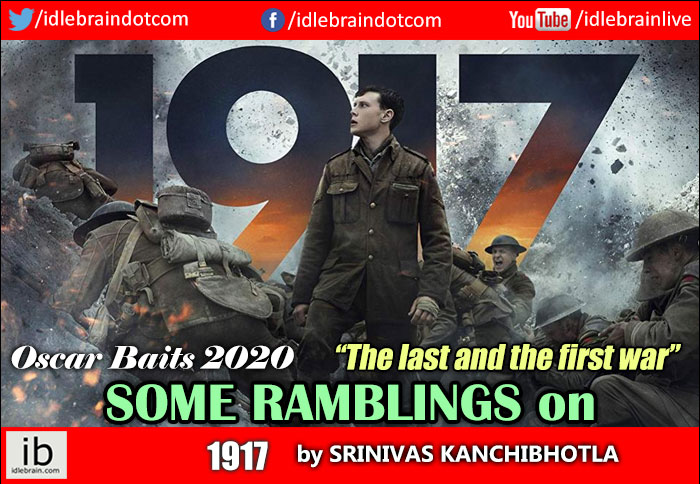
A soldier needs to relay a message 8 hours away about a certain trap and stop the impending push in its tracks.
The last war this scenario could probably be turned into a two hour movie was the first world war, the last one before the advent of modern communications, the last one where the message had to be hand delivered on foot, the last war that had cavalry on the front lines, bolt action bayonets and dogfights involving the current crop dusters doing a graceful ballet in the air, and war meant two sides rushing from opposite sides in wide open spaces. '1917' therefore had everything going for it, where all the war film tropes and conventions could be done away with and the action could be condensed at an individual level. No explosions, no mushroom clouds, no raining of bullets, no war rooms with huge maps in the background - how could a contemporary war film be conceived without any of this adrenaline? Sam Mendes just shows how, in a movie that is just one single continuous take.
Before the lion share of the (well deserved) credit is handed over to Roger Deakins, the cinematographer par excellence, the conception of the project demands as much appreciation as the execution of it. What Mendes was going for was an immersive experience about a war where most of the action happened on foot - walking in the trenches or rushing across fields - and modern weapons of warfare had't been invented yet. Trade the olive greens and the khakis for some grays and blues and swap the bayonets for muskets, and the first world war might as well be the American Civil War. Also, there can be no better immersive experience of the hellish conditions in war than the D-day invasion at Normandy in the opening sequence of 'Saving Private Ryan', there can no better sense of impending doom than was captured on the beaches of 'Dunkirk' across multiple fronts - land, sea and air, nor no better choreography in contained spaces than in 'Full Metal Jacket'. Wisely, Mendes does not attempt to go up against the previous bests and previous greats, instead, he takes an entirely different approach in that, he just follows the path of the soldier, step for step, beat for beat, filming the entire journey in real time in (what appears like) a single take. His chops as a theater director comes in handy as he choreographs the entire action across trenches, ditches, mines, barns, and fields weaving through the crowds, ducking through the explosions and running away from danger with the same dread and tread as the soldier himself. The amount of meticulous planning, rehearsals and choreography that went into the making of this movie alone is enough to raise the status of this effort from mere 'ambitious' to sheer 'audacious'. Planning is half the battle won, they say, never more true than in '1917'.
This movie is all technical, all aimed at placing the audience along side, before and behind the foot soldiers, showing only enough as what the soldiers see ducking behind mounds of dirt, hiding behind broken doors and destroyed columns, hearing never far than an earshot distance. Interesting experiment this, as far as photography is concerned, as there can be no external/fancy lighting schemes possible because the field of vision is the full 360 degrees, and there could no such thing as scene blocking here. However Deakins' amazing eye comes to the fore only during the later part of the movie after the nightfall when the action scenes shift into a dilipidated building against the background of 1. another building on fire 2. frequent flares. Deakins tried a similar effect of photographing against an all encompassing orange hue in the Vegas sequence of Blade Runner: 2049 and more specially in the climactic battle sequence (also against a burning building) in Skyfall, and his mastery seems to grow with each iteration, stepping out of the comfort zones of (every cinematographer's delight - ) dark territories. Dennis Gassner, the production designer, knows a thing or two about muddied and bloodied battlegrounds. His design for a razed city in the climax of 'Saving Private Ryan' was a sight to behold. Though the current battlefield was not as expansive as in 'Ryan', he surely makes it up with never ending trenches, (barbed wire) fence fields, muddy ditches and the piece de resistance, the razed building. With the rest of the technical crew honorably acquitting themselves, '1917' is a different kind of war film, more like one put on a (very large) stage where the fun part is watching all the countless stage hands and the actors scrambling and scurrying in perfect coordination putting together a show that is not just seamless but priceless, not just for the execution, but for the effort!
Oscar Baits 2020:
The Irishman
Bombshell
Once upon a time in Hollywood
checkout http://kanchib.blogspot.com for Srinivas's Blog.
